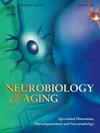听觉分心、时间感知和年龄的作用:来自大型队列研究的 ERP 证据
IF 3.7
3区 医学
Q2 GERIATRICS & GERONTOLOGY
引用次数: 0
摘要
认知老化通常与更易受同时出现但与任务无关的刺激干扰有关。在此,我们研究了多特蒙德生命研究(Clinicaltrials.gov NCT05155397)中 484 名 20-70 岁健康成年人的认知子过程。受试者对音调刺激的持续时间进行判断,这些音调刺激由随机序列的长音和短音组成,音调要么是规则(标准)音调,要么是罕见(偏差)音调。研究人员探讨了与偏差相关的ERP,这些ERP反映了注意前偏差检测(MMN)、对偏差的注意分配(P3a)和处理(P3b)以及对任务相关刺激特征的重新定向(RON)的神经认知相关性。对偏差长音的准确度降低,可能是由于注意力从处理时间信息中撤出,使长刺激显得更短。这种效应随着年龄的增长而增加,对 ERPs 和年龄的相关性进行的基于聚类的置换检验以及线性混合模型表明,MMN 下降,P3a 随长音增加,P3b 和 RON 下降。这表明随着年龄的增长,对偏离刺激特征的注意定向增加,而对任务相关特征的重新定向减少。本文章由计算机程序翻译,如有差异,请以英文原文为准。
Auditory distraction, time perception, and the role of age: ERP evidence from a large cohort study
Cognitive aging is typically associated with a higher susceptibility to distraction by concurrent, but task-irrelevant stimuli. Here, we studied the cognitive sub-processes involved in a sample of 484 healthy adults aged 20–70 years from the Dortmund Vital Study (Clinicaltrials.gov NCT05155397). Participants judged the duration of tone stimuli of a random sequence of long and short tones, having either a regular (standard) pitch or rare (deviant) pitch. Deviance-related ERPs were explored, reflecting neuro-cognitive correlates of pre-attentive deviance detection (MMN), attention allocation toward (P3a) and processing of (P3b) the deviance, and re-orienting toward the task-relevant stimulus feature (RON). Accuracy was reduced for deviant long tones, possibly due to withdrawing attention from processing the time information, making long stimuli appear shorter. This effect increased with age, and cluster-based permutation tests on the correlation of ERPs and age as well as linear mixed modeling indicated a decrease in MMN, an increase in P3a with long tones, and decreases in P3b and RON. This suggests a greater attentional orienting to the deviant stimulus feature and a reduced re-orienting to the task-relevant feature with increasing age.
求助全文
通过发布文献求助,成功后即可免费获取论文全文。
去求助
来源期刊

Neurobiology of Aging
医学-老年医学
CiteScore
8.40
自引率
2.40%
发文量
225
审稿时长
67 days
期刊介绍:
Neurobiology of Aging publishes the results of studies in behavior, biochemistry, cell biology, endocrinology, molecular biology, morphology, neurology, neuropathology, pharmacology, physiology and protein chemistry in which the primary emphasis involves mechanisms of nervous system changes with age or diseases associated with age. Reviews and primary research articles are included, occasionally accompanied by open peer commentary. Letters to the Editor and brief communications are also acceptable. Brief reports of highly time-sensitive material are usually treated as rapid communications in which case editorial review is completed within six weeks and publication scheduled for the next available issue.
 求助内容:
求助内容: 应助结果提醒方式:
应助结果提醒方式:


